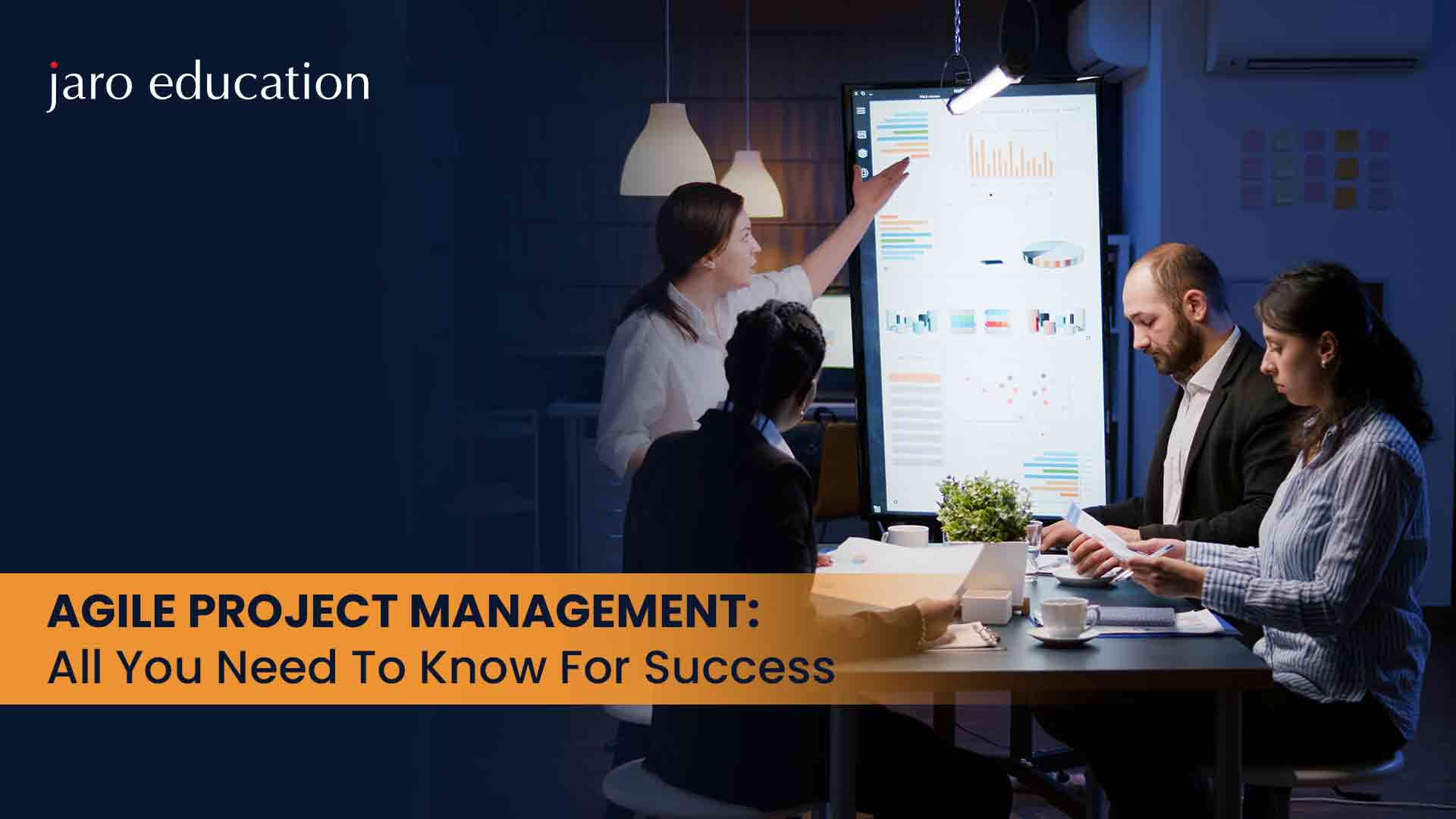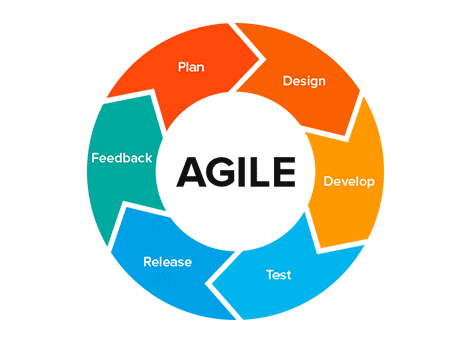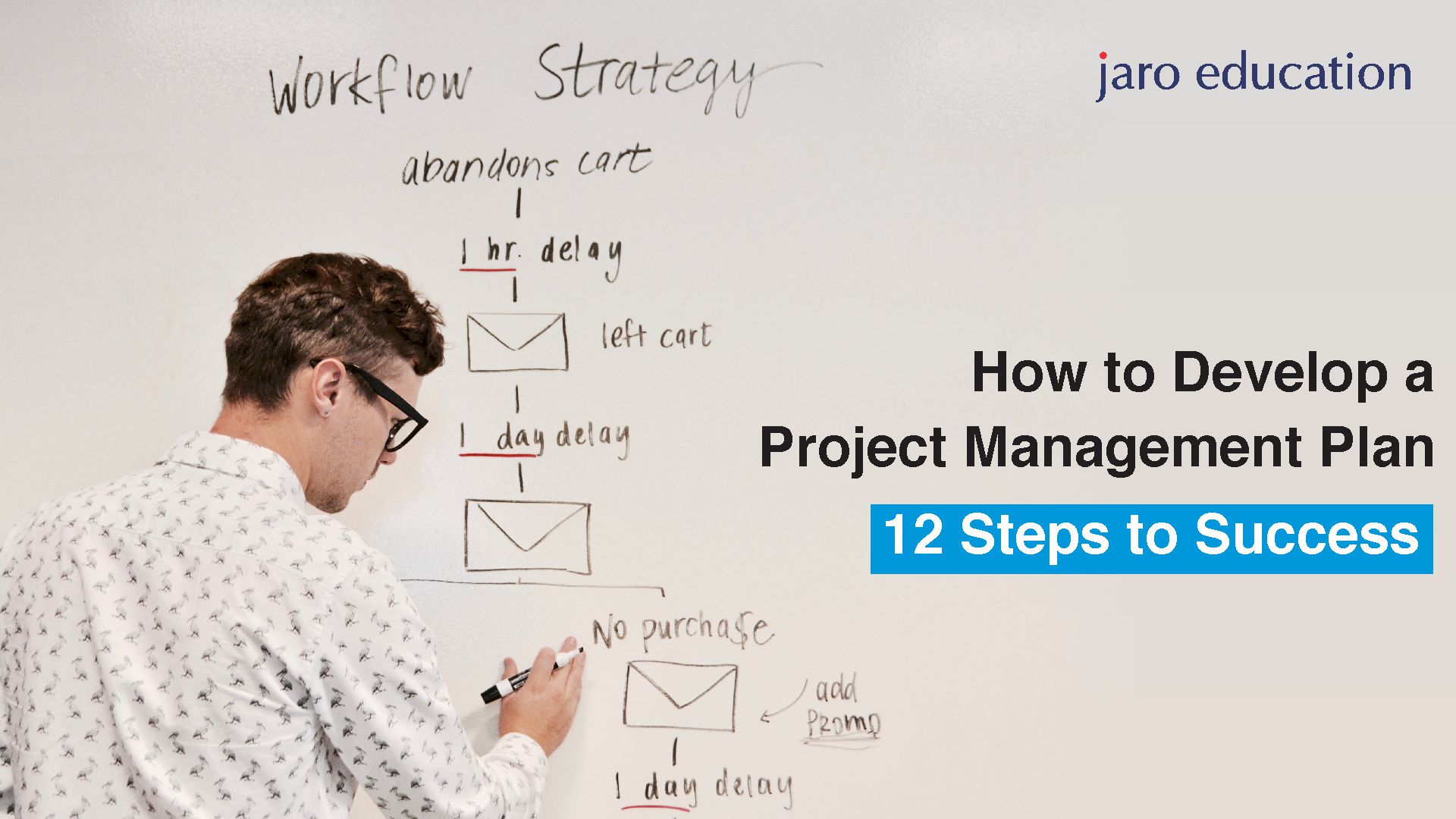Agile Project Management: All You Need To Know For Success
Table of Contents

- jaro education
- 25, September 2024
- 1:00 pm
Transform your project management game with Agile Project Management, it isn’t just a method; it’s a game-changer. Agile Project Management gives rise to a flexible and adaptive regime of project management that has an assurance of timeliness, compliance with the budget, and qualitative results. Agile Project Management does well in dynamic environments because of its nature of iterative progress, continuous feedback, and collaboration between team members. Therefore, organizations can respond quickly to dynamic demands and reduce risks in order to facilitate further innovation. Agile project management is not just a methodology but an asset vital for success for any organization.
Understanding Agile Project Management
Agile Project Management is a paradigm shift from the traditional, linear methods of project management to a dynamic and iterative approach.Traditional methodologies follow a structured cycle of phases related to initialization, planning, execution, monitoring, and closure, Agile Project Management works on flexibility and continuous improvement. Agile Project Management reduces risks by breaking projects into small iterations, injects continuous feedback, and copes well with changes.
Agile vs. Traditional Project Management: While traditional methods may work where the goals are well understood and the changes are at a minimum, APM’s iterative cycles certainly apply more strongly in an environment of rapid change and customer feedback. APM places much emphasis on adaptability, collaboration, and incremental delivery to align projects towards evolving requirements and stakeholder needs. Example of Agile Project Management is Spotify, that makes use of the Agile framework, and it shows how the methodology can push innovation and feature releases faster in the competitive market.
Key Principles of Agile Project Management
Key values drive Agile Project Management to deliver excellence in project execution. The guiding principles can be elaborated as follows:
Customer Satisfaction: Agile Project Management places the satisfaction of customers at the heart of its approach, striving for early and continuous delivery of value. This offers regular updates and incremental releases to help in trust-building and closer alignment of the product to customer needs and expectations.
Embrace Change: Agile embraces change even later in the development stage. The adaptability inherent in the methodology enables teams not only to enhance product value but also to be responsive to the changing market trends, so that when the final deliverable meets existing demands.
Frequent Delivery: The principle of agile on delivering functional software in small frequent increments allows for continuous improvement. This iterative approach, feedback incorporation and refinement of the product on a regular basis lead to more effective and timely updates.
Collaboration: Agile methodologies also ensure active collaboration by business stakeholders with the developers right from the inception to the end of a project. This helps in ensuring that all views are put into consideration, problems are detected on time, and the project aligns with the strategic objectives.
Motivated Teams: Agile provides a very creative environment and a team-friendly atmosphere that motivates team members. By giving teams autonomy and space for innovation, Agile allows teams to give their full contribution towards work.
Face-to-Face Communication: Agile prefers face-to-face conversation as the best way people can share information. There is clarity and expedited feedback, problems can be solved much faster.
Functional Software: In Agile, progress is measured based on the functional software delivered. Functional output means that the project remains concentrated on tangible and valuable results.
Sustainable Work: Consistency of work prevents the risk of burnout and increases efficiency. Agile promotes sustainable work habits that foster team health and project success in the long run.
Technical Excellence: Continuous skill and design improvements are at the very heart of Agile. Teams are empowered to seek out technical perfection and further hone their practices to best enhance agility and resilience.
Simplicity: Agile advocates simplicity in delivering only what is necessary and eliminating unnecessary complexities. Resources are optimized through enhanced effectiveness of projects.
Self-Organizing Teams: Agile supports self-organizing teams. With the right to decide exactly how to handle a given work, Agile supports novelty in problem-solving and efficiencies in workflows.
Continuous Reflection: Agile supports frequent reflection on practices and processes. Teams undergo review of performance that leads to making necessary adjustments for collaboration, efficiency, and project outcomes.
These core values underpin Agile Project Management in its assistance to teams addressing such complexities and delivering outstanding results.

Popular Agile Frameworks
Scrum
Scrum is an extremely popular way of dealing with complex projects by dividing them into brief, workable bits called sprints. Basically, it depends on three main roles: the Scrum Master, who keeps the team on track; the Product Owner, representing the interests of the customer; and the Development Team, which performs the actual work. Scrum also integrates the planning of regular meetings at the beginning of each sprint, daily check-ins, reviews at the end of each sprint, and reflection meetings on what went right and what could be improved.
Kanban
Kanban is a way of managing work by using a visual board of columns, think of a board where columns are labeled “To Do,” “In Progress,” and “Done.” Items go from one column into the next as they are worked on and then completed. Kanban is great for those jobs that are ongoing in nature and need constant renewal, handling daily tasks or keeping things running smoothly.
Lean
Lean was originally developed in manufacturing to help things run more smoothly. It means giving the most value to customers and using the least amount of time, money, and resources. Think of this as fine-tuning some process to get rid of steps that do not add value, therefore accelerating and smoothing everything out. This concept of lean is useful for the industries that need to make its processes streamlined and reduce waste.
Advantages of Agile Project Management
Agile Project Management boasts an array of benefits that add weight to the consequent success of a project and teamwork:
Flexibility and Responsiveness: Agile is really quick in adapting to changing requirements. This enables teams to meet customer needs by adjusting their plans quickly. This flexibility ensures projects remain relevant and aligned with market demands.
Improved communication and collaboration: Agile encourages open lines of communication and frequent interaction. The collaboration environment encourages knowledge sharing and problem-solving that lead to cohesive project executions.
Faster Time-to-Market: Agile enables the faster delivery of projects through breaking up the work into manageable increments called sprints. It iteratively helps in quicker releases of functional segments of a product, hence bringing faster time-to-market and quicker benefits realization.
Continuous Improvement: Agile methodologies provide emphasis on regular reflections for iterative improvements. Teams often perform reflections where progress review, ways of improving , and implementation actually take place to nurture a culture of continuous improvement.
More Customer Focus: Agile Project Management keeps the customer at the center of the development process through regular feedback and iterative releases. This ensures that the final product has very close alignment with customer expectations and will deliver maximum value to the customer.
These benefits put together make Agile methodology powerful in managing projects in eclectic and fast-paced environments.

*accurate reviews
Upskill Your Knowledge with IIM Mumbai’s Certificate Programme in Advanced Project Management and Analytics
The Executive Certificate Programme in Advanced Project Management and Analytics from IIM Mumbai, through Jaro Education, provides a very unique opportunity to comprehend various critical aspects in the domain of project management. This program is specially designed for senior executives who operate complex projects in VUCA environments and thereby equip them with skills to accomplish project success within strict time and cost restrictions. This is achieved through the thorough design of the curriculum in such a way that it seeks to resolve real-world challenges through strategic decision-making so that participants can gain actionable knowledge they can apply to bring about project success and stimulate further organizational growth.
Additionally, the program fosters a deep understanding of advanced analytics techniques, enabling executives to drive data-informed decisions that enhance project outcomes. By participating in this program, leaders are prepared to navigate the complexities of modern project environments and lead their teams to achieve superior performance and sustainable results.
Programme Highlights
Executive Alumni Status: Get an elite distinction from IIM Mumbai which enhances your professional credibility and networking in the industry.
Certificate of Completion: Avail an elite certificate from one of the top-ranked management institutes in India, testifying to your deepened knowledge in project management.
Live Interaction with Experts: Directly interact with the top academics and industry leaders and learn from their rich experience and current best practices in project management.
Hands-on Sessions: Engage in interactive sessions on advanced project management tools and techniques and become proficient in working with complex projects.
Immersive Learning: Experience the 3-day campus immersion, in-depth case studies, and real-industry projects that provide an in-depth overview of project management principles and help participants apply them to real-life situations.
Key Tips for Successful APM Implementation
APM implementation can be successfully made by creating a facilitative environment that allows cooperation and continuous improvement.
Encourage Open Culture: Promote open communication and active listening. Create forums where team members can openly share their ideas and feedback without fear. This transparency helps in identifying issues right at the beginning and helps build trust.
Team Empowerment: Give the power of decision-making and foster self-organizing teams. This helps accelerate decision-making and helps develop a sense of ownership. Let them experiment with identifying the best approaches for completing their tasks.
Embrace Failure as an Opportunity to Learn: Treat failures as learning opportunities.Conduct thorough reviews to investigate the mistakes made and take necessary steps to prevent similar errors in the future. Create a culture of experimentation for innovating.
Cross-functional Teams: Create diverse teams in terms of skill and perspectives. Encourage interaction within daily work and deploy collaboration tools for the team to use. It brings diversity into problem-solving and innovation.
Clearly Communicate Direction: Set clear goals and objectives, communicating them to the team. Kanban boards help visualize and provide better direction. Regularly update the roadmap to manage expectations and keep the team aligned.
Continuous Improvement: Reflections improve processes routinely; celebrating small wins keeps morale high and positive practices should be reinforced.
Organizations that pay attention to these focus areas, will be well on their way to implementing effective APM.
Conclusion
Agile Project Management presents an exciting way to manage projects in today’s times, when one needs to be flexible, collaborative, and continuously have an edge. Agile Project Management principles integrated into organizations, complemented by highly specialized training like the Executive Certificate Programme from IIM Mumbai, would definitely help build a very strong project management framework that would enable project managers to lead efficiently. Shape your future with Agile Project Management tools to ensure successful project deliveries and career growth.
Frequently Asked Questions
The Agile Life Cycle are the phases in Agile Project Management: Concept, Inception, Iteration/Increment, Release, and Maintenance. It contains iterative-incremental phases that are continually reviewed on a regular basis for flexibility and continuous feedback.
Agility means flexibility, collaboration, and iterative progress. Projects are divided into sprints or iterations so that work can be delivered incrementally. The strategy promotes close collaboration with stakeholders, frequent reassessment of goals, and adaptation to emergent requirements; it is therefore highly responsive and efficient in projects.
Frameworks include Scrum, which uses time-boxed sprints with specified roles and events; Kanban, which visualizes stages of work and manages flow; and Lean, which focuses on a core principle of reducing waste and optimizing processes. Each one of these can add value to project management by providing more flexibility, better communication, and continuous improvement.
Some of the myths involve the perception that Agile is all about chaos and unorganized work, or applies only to software development. As a matter of fact, Agile proposes a structured methodology with iterative planning, and it could span across different industries since one is afforded leeway toward managing projects effectively under dynamic environments.








